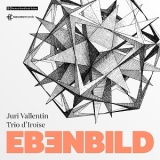Die Melodie zu ‘O Haupt voll Blut und Wunden’ hat Johann Sebastian Bach sein Leben lang begleitet. Er hat sie mit anderen Texten mehrfach verwendet. Und auch andere Musiker setzten sich damit auseinander. Die Musik, die von Leo Hassler und seinem ‘Mein Gmüth ist mir verwirret’ über Bach bis zu Theo Verbey reicht, liefert verschiedenartigste Auseinandersetzungen mit dieser Tonfolge. Einige der Namen und damit der Werke dürften weitgehend unbekannt sein. Diese Mischung wirkt dabei nicht beliebig, sondern webt ein Geflecht, in dem der frühbarocke Text in fünf Strophen, jeweils bestimmten Werken zugeordnet, in die Musik eingestreut rezitiert wird. Diese Reise mit unterschiedlichen Blickwinkeln liefert ein ebenso überraschendes wie stimmiges Konzept, das den Titel Ebenbild bekommen hat.
Ein in neun Felder gefaltetes Blatt liefert anstelle eins Beiheftes die Gedanken der Interpreten und allen notwendigen Informationen. Oboist Juri Vallentin, das Trio d’Iroise gestalten zusammen mit dem Cembalisten Bernward Lohr die Musik, die Rezitative trägt Caroline Junghanns vor. Die Musiker vermitteln den Trost und die Hoffnung, die im Text und in der Musik zum Ausdruck kommt mit ihrem hochintensiven, gleichwohl kammermusikalisch fein austarierten Spiel. Die Gestaltung und Ausführung des Konzepts hat sich erkennbar in tiefempfundenen Interpretationen realisiert, so dass die Auseinandersetzung sowohl geistig als auch emotional sehr lohnend ist. Mich stört lediglich, dass die Zitate mit Haltetönen unterlegt sind, was ich als unnötig bzw. sogar vom Text ablenkend empfinde.
The melody to O Haupt voll Blut und Wunden accompanied Johann Sebastian Bach throughout his life. He used it several times with other texts. The music, which ranges from Leo Hassler and his Mein Gmüth ist mir verwirret over Bach to Theo Verbey, provides a variety of approaches to this sequence of notes. Some of the names and thus the works are likely to be largely unknown. This mixture does not seem arbitrary, but weaves a program in which the early baroque text is recited in five stanzas, each assigned to specific works, interspersed in the music. This journey with different perspectives provides a concept that is as surprising as it is coherent, and which has been given the title Ebenbild (Llikeness).
A sheet folded into nine parts provides the thoughts of the performers and all necessary information instead of a booklet. Oboist Juri Vallentin as well as the Trio d’Iroise and harpsichordist Bernward Lohr play the music, while the recitatives are performed by Caroline Junghanns.
The musicians convey the consolation and hope expressed in the text and the music with their highly intense, yet finely balanced chamber music playing. Thus, the original concept has been characteristically realized in deeply felt interpretations, making the listening both spiritually and emotionally rewarding. The only thing that bothers me is that the quotes are punctuated with sustained tones, which I find unnecessary or even distracting from the text.
























